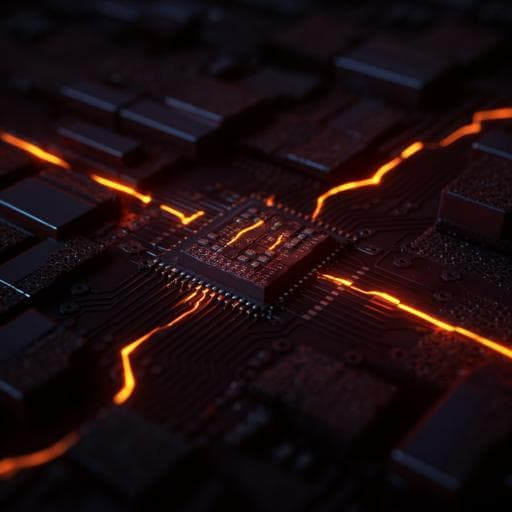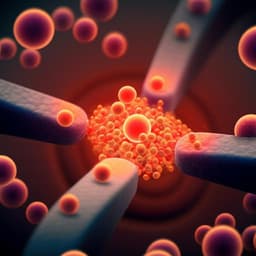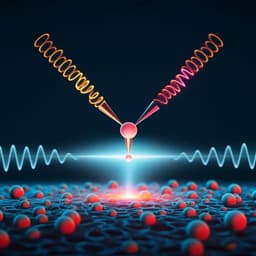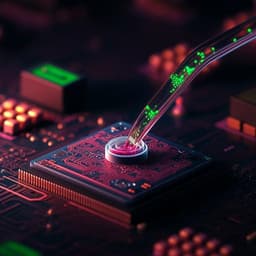
Engineering and Technology
A quantum sensing metrology for magnetic memories
V. J. Borràs, R. Carpenter, et al.
This groundbreaking research, conducted by Vicent J. Borràs, Robert Carpenter, Liza Žaper, Siddharth Rao, Sebastien Couet, Mathieu Munsch, Patrick Maletinsky, and Peter Rickhaus, unveils a non-contact metrology technique leveraging scanning NV magnetometry for detailed analysis of Magnetic Random Access Memory at the bit level. The findings not only reveal critical magnetic properties but also pave the way for enhanced failure analysis in MRAM production.
~3 min • Beginner • English
Introduction
The paper addresses the metrology challenges posed by continued scaling of magnetic memory bits, particularly in spin-transfer torque magnetic random access memory (STT-MRAM). As MRAM bits shrink (<60 nm diameter, <2 nm magnetic layers), achieving uniformity and tight distributions of key properties (e.g., anisotropy, volume, switching energy barrier) becomes critical for yield, reliability, and expanding application space. Traditional metrology—such as magneto-optical Kerr effect (MOKE) and current-in-plane tunneling (CIPT)—either averages over large ensembles or only measures unpatterned films, providing limited or delayed feedback on individual-bit behavior. The research question is whether scanning nitrogen-vacancy magnetometry (SNVM), a nanoscale, non-contact, highly sensitive magnetic field imaging technique, can characterize individual MRAM bits directly after etch (pre-metallization), quantify their magnetic properties and switching statistics, reveal out-of-distribution bits (including edge-related anomalies), and thereby serve as an effective in-line or early-stage process development metrology tool.
Literature Review
- CIPT enables measurement of as-deposited film properties on unpatterned wafers but cannot access individual bits and typically requires metallization for device-level characterization. It provides film resistances with spatial resolution >~60 µm.
- MOKE (including polar MOKE) is widely used before and after patterning to measure ensemble magnetic properties and hysteresis but averages over large spot sizes (>~40–60 µm), lacking single-bit sensitivity and being influenced by peripheral magnetic material within the spot. While smaller spot sizes exist, they are still insufficient for industrially relevant MRAM single-bit resolution.
- Conductive AFM (cAFM) can probe patterned devices electrically after etch but requires direct tip contact with pillars, complicating in-line metrology.
- Magnetic force microscopy (MFM) can map arrays non-electrically but is invasive, has limited resolution (tip >30 nm), lower magnetic sensitivity, and tip variability affecting reproducibility, limiting in-line applicability.
- SNVM offers non-contact nanoscale magnetic imaging with high field sensitivity and ~20–100 nm resolution and can be applied after patterning without metallization, potentially filling the metrology gap by measuring single-bit states, switching distributions, and thermal stability rapidly compared to lengthy thermal bake tests.
Methodology
Devices and processes:
- Industrially relevant 300 mm wafers were fabricated with STT-MRAM pillar arrays. Two etch processes were benchmarked:
• Process 1: MTJ etch → oxidation → encapsulation.
• Process 2 (optimized): MTJ etch → oxidation → etchback + gentle oxidation → encapsulation.
- Pillar design: nominal 60 nm diameter, 200 nm pitch; after patterning, physical diameter ~45 nm. MTJ stack: CoFeB free layer (FL), MgO tunnel barrier, CoFeB reference layer (RL). Arrays encapsulated with SiN.
SNVM measurement setup and protocol:
- Dies were diced from 300 mm wafers. SNVM performed with a Qnami ProteusQ microscope using a single NV center near a diamond pillar apex. The NV axis is tilted by 54.5° from the surface normal and aligned at 0° in-plane relative to x. The stray field is measured ~150 nm above the FL (including cap, hardmask, encapsulation, and ~50 nm flying height).
- Optically detected magnetic resonance (ODMR) around 2.8 GHz tracks the |m_s = −1⟩ resonance shift to measure the NV-projected magnetic field. Typical scans: 100 × 100 pixels, ~1.5 h per map.
- Bit state preparation: Initialize all bits to parallel (P) by sweeping out-of-plane field to μ0H = 160 mT. Apply a negative switching field μ0H_switch, then image at a small bias field (H = 2 mT). Acquire maps for various μ0H_switch.
- Edge behavior: Bits near array edges (rows/cols 1–2, extending to 1–4) show anomalous switching asymmetry (P vs AP) likely due to RL stray-field bias and/or altered etch at edges. Rows/columns 1–4 were excluded from quantitative analyses.
Data extraction and analysis:
- From each stray-field map, an optimized grid localizes pillars; per-bit mean NV-projected stray field determines state (P/AP) and the maximum field ΔB_NV,max for distribution analysis.
- P vs μ0H_switch curves are fit using a Néel–Brown relaxation model with domain-wall-mediated reversal (DWMR): attempt frequency f0 = 1 GHz; sweep rate R = 5 mT/s; T = 298 K. The model yields thermal stability Δ and anisotropy field H_k; normalization accounts for incomplete switching into AP at large negative fields. Domain wall width δ_w estimated via standard relation.
- Switching statistics: At a μ0H_switch giving ~46% P per measurement, the initialization–switch–map cycle is repeated 10 times. For each bit, the number of successful switches is counted; histograms and variances are compared to a binomial reference to quantify array uniformity.
Simulations:
- Magpylib-based forward modeling of arrays representing FL, RL, and hard layer (HL) as stacked cylinders. Representative parameters (Process 2 comparison):
• Thicknesses (nm): FL 1.2, RL 1.4, HL 3.8.
• Magnetizations (MA/m): FL ±1.175 (P/AP), RL +0.790, HL +0.550; FL magnetization magnitude normally distributed with σ = 0.235 MA/m.
• Critical dimension normally distributed: mean 38.1 nm, σ = 0.8 nm (from SEM).
• Magnetization direction spreads: RL σ ≈ 10°, FL σ ≈ 5° (out-of-plane centered).
• NV probe at 151 nm above FL, axis 54.5° tilt.
- Simulated maps and histograms were compared to SNVM data; simulated switching probabilities and switching-count histograms were generated to reproduce experimental trends.
Key Findings
- SNVM resolves individual bit states in encapsulated arrays (45×45 bits per map) within ~1.5 h, enabling post-etch, pre-metallization metrology.
- Edge-related anomalies: Arrays can be fully initialized to P but not to AP even with fields exceeding average coercivity, consistent with RL stray-field bias. Edge rows/columns exhibit pronounced asymmetry and out-of-distribution behavior, prompting exclusion of rows/cols 1–4 from analysis.
- Process discrimination:
• Fraction of P vs μ0H_switch shows 50% switching near ~85 mT (Process 1) and ~110 mT (Process 2). Polar MOKE on films gives μ0H_c ≈ 110 mT for both and cannot distinguish processes due to ensemble averaging; SNVM clearly distinguishes them at the bit level.
- Thermal stability and anisotropy (from DWMR + Néel–Brown fits):
• Process 1: Δ = 49; μ0H_k = 440 ± 2 mT; estimated domain-wall width δ_w ≈ 6 nm.
• Process 2: Δ = 54; μ0H_k = 533 ± 2 mT; δ_w ≈ 5 nm.
- Bit-to-bit uniformity from stray-field distributions (ΔB_NV,max, P state):
• Process 1: σ_B ≈ 250 μT.
• Process 2: σ_B ≈ 136 μT (narrower, indicating improved uniformity).
- Switching statistics over 10 repetitions at ~46% P:
• Process 1: 12% of bits switch zero times; 9% switch all 10 times.
• Process 2: 8% zero; 6% ten times.
• Ideal binomial expectation: ~0.2% zero; ~0.04% ten times. Variances: σ_switching ≈ 10.7 (Process 1), ≈ 9.3 (Process 2), vs binomial σ ≈ 2.5, indicating significant non-uniformity mitigated by Process 2.
- Correlation: In Process 2, bits with higher average stray fields tend to switch more often under identical conditions, linking stray-field distributions to switching behavior and enabling uniformity assessment from a single initialized map.
- Simulations reproducing Process 2 behavior indicate that non-binomial switching arises from realistic distributions in pillar magnetization magnitude/direction and critical dimension, tying metrology observables to key device-health metrics (thermal stability, read/write currents).
Discussion
The study demonstrates that SNVM provides direct, single-bit sensitivity to magnetic states and switching in industrially relevant STT-MRAM arrays immediately after the etch step. By imaging stray-field contrast and applying controlled initialization/switching protocols, SNVM quantifies process-dependent differences in coercive behavior, anisotropy, thermal stability, and bit-to-bit uniformity that ensemble methods (e.g., MOKE) cannot resolve. The observed edge-associated anomalies and the inability to fully initialize into AP emphasize the importance of local metrology and highlight process non-uniformities that can be targeted for optimization. Statistical switching analysis shows strong deviations from binomial behavior due to underlying distributions in magnetic and structural parameters, with the optimized etch process measurably reducing these deviations. The strong correlation between stray-field distributions and switching statistics suggests that single-map measurements can serve as rapid proxies for array uniformity and retention assessment. Combined with simulations, the work links measured metrology signatures to physical variations in magnetization and dimensions, providing actionable insights for process tuning and early failure analysis.
Conclusion
SNVM is established as a powerful, non-contact metrology for MRAM that operates at the single-bit level directly after etch, without requiring metallization. It distinguishes process variants, quantifies thermal stability (Δ) and anisotropy (H_k), identifies out-of-distribution (tail) bits including edge-related anomalies, and assesses array uniformity via stray-field distributions and switching statistics. The approach aligns with prior electrical characterizations of similar processes, supporting its validity for early-stage process development and screening. Future work can focus on accelerating SNVM toward AFM-like speeds by reducing pixels per bit and ODMR frequencies, optimizing integration times, and improving hardware–software throughput—potentially enabling in-line process control. Additional capabilities such as localized heating or perturbation fields could probe data-retention probabilities under application-relevant environments. The demonstrated methodology is extensible to emerging magnetic memory systems, including those with smaller magnetic moments (e.g., antiferromagnets), broadening its industrial metrology impact.
Limitations
- Edge effects: Rows/columns near the array edges exhibit anomalous, asymmetric switching behavior; the study excludes rows/cols 1–4 from quantitative analyses, and conclusive edge-switching statistics remain elusive.
- Initialization asymmetry: Arrays can be fully initialized to P but not to AP, even at large negative fields, necessitating normalization in model fits and complicating full-state symmetry assessments.
- Throughput: Current SNVM scans (e.g., 100×100 pixels, ~1.5 h per 2 kB array map) limit throughput; while still faster than long thermal bake tests, significant speed improvements are needed for routine in-line control.
- Measurement standoff: The NV–FL distance (~150 nm including layers and flying height) reduces measured field amplitudes and requires careful modeling to extract intrinsic parameters.
- Model assumptions: Extraction of Δ and H_k relies on the Néel–Brown + DWMR framework and assumed material parameters; deviations from these assumptions or unaccounted device-to-device variations may affect quantitative values.
Related Publications
Explore these studies to deepen your understanding of the subject.







